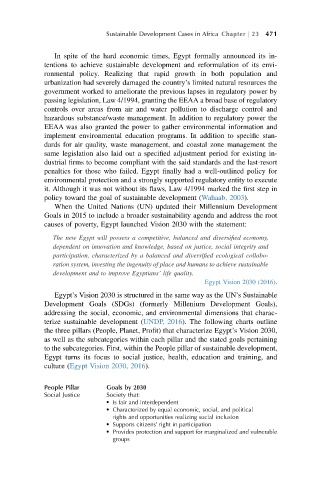Page 501 - Sustainable Cities and Communities Design Handbook
P. 501
Sustainable Development Cases in Africa Chapter j 23 471
In spite of the hard economic times, Egypt formally announced its in-
tentions to achieve sustainable development and reformulation of its envi-
ronmental policy. Realizing that rapid growth in both population and
urbanization had severely damaged the country’s limited natural resources the
government worked to ameliorate the previous lapses in regulatory power by
passing legislation, Law 4/1994, granting the EEAA a broad base of regulatory
controls over areas from air and water pollution to discharge control and
hazardous substance/waste management. In addition to regulatory power the
EEAA was also granted the power to gather environmental information and
implement environmental education programs. In addition to specific stan-
dards for air quality, waste management, and coastal zone management the
same legislation also laid out a specified adjustment period for existing in-
dustrial firms to become compliant with the said standards and the last-resort
penalties for those who failed. Egypt finally had a well-outlined policy for
environmental protection and a strongly supported regulatory entity to execute
it. Although it was not without its flaws, Law 4/1994 marked the first step in
policy toward the goal of sustainable development (Wahaab, 2003).
When the United Nations (UN) updated their Millennium Development
Goals in 2015 to include a broader sustainability agenda and address the root
causes of poverty, Egypt launched Vision 2030 with the statement:
The new Egypt will possess a competitive, balanced and diversified economy,
dependent on innovation and knowledge, based on justice, social integrity and
participation, characterized by a balanced and diversified ecological collabo-
ration system, investing the ingenuity of place and humans to achieve sustainable
development and to improve Egyptians’ life quality.
Egypt Vision 2030 (2016).
Egypt’s Vision 2030 is structured in the same way as the UN’s Sustainable
Development Goals (SDGs) (formerly Millenium Development Goals),
addressing the social, economic, and environmental dimensions that charac-
terize sustainable development (UNDP, 2016). The following charts outline
the three pillars (People, Planet, Profit) that characterize Egypt’s Vision 2030,
as well as the subcategories within each pillar and the stated goals pertaining
to the subcategories. First, within the People pillar of sustainable development,
Egypt turns its focus to social justice, health, education and training, and
culture (Egypt Vision 2030, 2016).
People Pillar Goals by 2030
Social Justice Society that:
l Is fair and interdependent
l Characterized by equal economic, social, and political
rights and opportunities realizing social inclusion
l Supports citizens’ right in participation
l Provides protection and support for marginalized and vulnerable
groups

